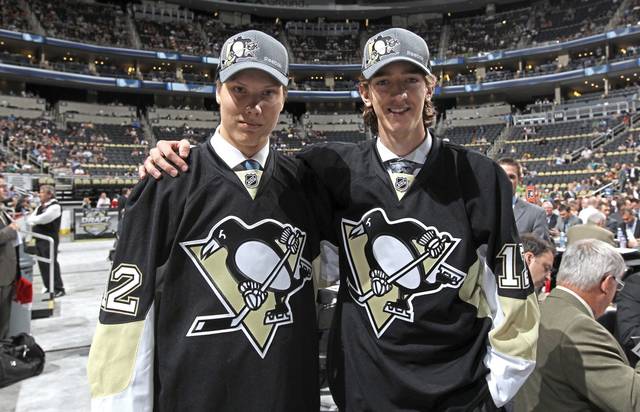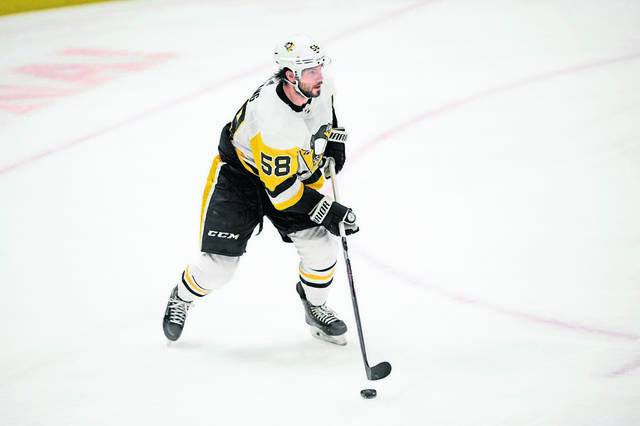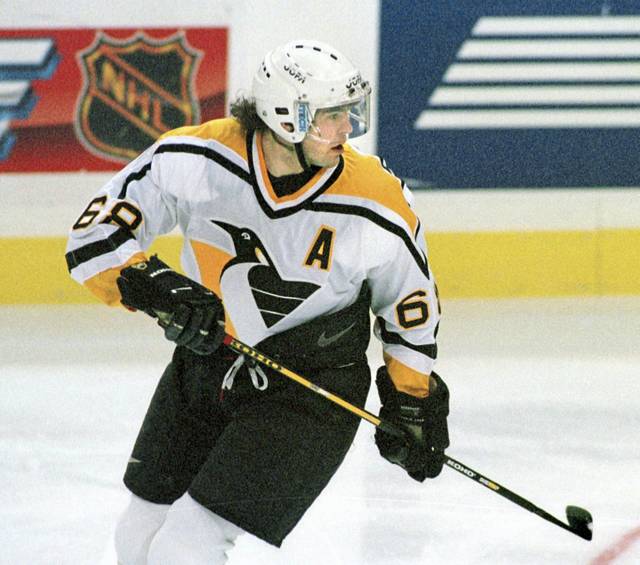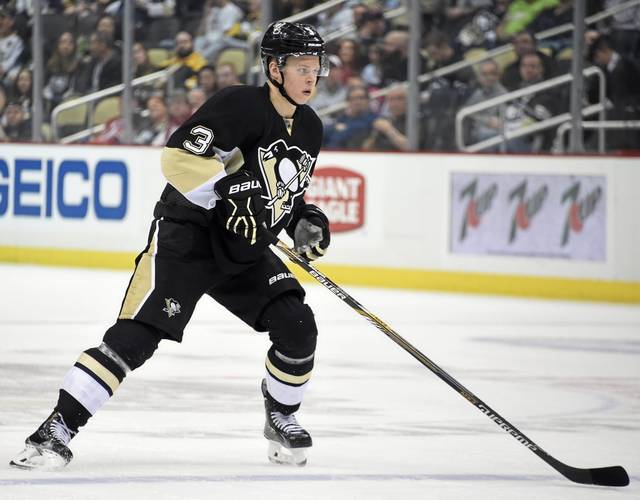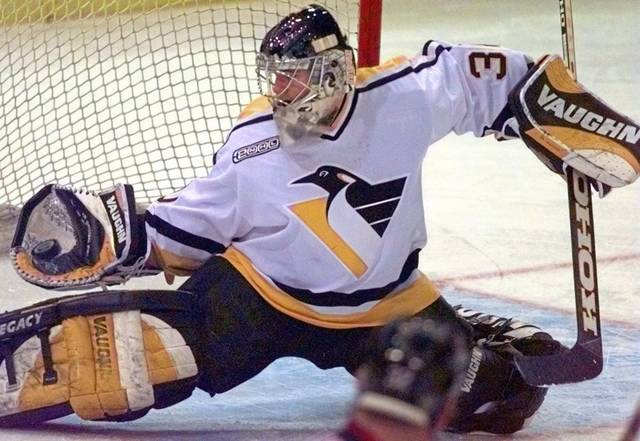What was the Penguins' best draft class ever?
Oskar Sundqvist hasn’t been a member of the Penguins organization for three years. In 2017, the two-way forward was sent to the St. Louis Blues as part of a doomed — from the Penguins’ perspective — trade for enforcer Ryan Reaves.
Yet, even with that much separation, Penguins goaltender Matt Murray still refers to his former teammate by his nickname.
After all, they were drafted together back in 2012.
In the third round, with the 81st overall selection that was acquired from the Phoenix Coyotes (by way of the Philadelphia Flyers), the Penguins selected a lanky center from Skelleftea in Sweden by the name of Oskar Sundqvist. Two picks later, they selected Murray, a skinny goaltender from Sault Ste. Marie of the Ontario Hockey League.
“’Sunny’ and I were drafted kind of right next to each other in the order, so we kind of did our whole media (obligations) together,” Murray said. “We were together most of the day. I definitely remember that.
“It was here in Pittsburgh. That was cool. My parents were there with me, my agent. Just an exciting day honestly. It was the start of a dream. I have nothing but fond memories.”
That draft class was significant for a variety of reasons for the Penguins. Namely, it produced five NHL players — a high total by most evaluations — and helped them win the Stanley Cup in 2016 and 2017.
But was it the Penguins’ best draft class ever?
The following is an evaluation of the Penguins’ five best draft classes. For the purposes of this exercise, value was placed on quantity, both in the number of players it produced and how many games they played. The 1984 draft, for example, produced a legend in Mario Lemieux, but only one other full-time NHL player.
1. 2005 – Sidney Crosby, Kris Letang and Joe Vitale
Sure, taking Crosby with the top overall pick didn’t require extensive work by the amateur scouting staff. A bounce of a few ping pong balls ensured the Penguins would have their next franchise savior. Regardless, few players have meant more to the fortunes of a franchise more than Crosby. The three most recent Stanley Cup banners that hang from the rafters of PPG Paints Arena are evidence of that.
Letang was something of a find as the first pick of the third round. Over 14 seasons, he became the franchise’s greatest defenseman by any measure, especially all the offensive records he holds for the franchise’s blue liners. This past winter, he was selected for an All-Star game for the sixth time.
Vitale was hardly a significant contributor to the Penguins, but he was good enough to be a fourth-line center for some pretty good teams in the early 2010s. And a seventh-rounder getting 200-plus games on his resume is no small accomplishment.
2. 2004 – Evgeni Malkin, Alex Goligoski and Tyler Kennedy
Much like Crosby, Malkin wasn’t a difficult pick. After losing the draft lottery and missing out on a chance to select future star forward Alex Ovechkin, the Penguins wound up with Malkin, who might prove to be the greatest all-around Russian player in NHL history.
Goligoski is one of the relatively rare successes the Penguins have had with second-round picks. He only spent four seasons with the Penguins but was highly productive during that time with 90 points in 177 games and even collected a Stanley Cup ring in 2009. During the 2010-11 season, he was sent to the Dallas Stars in a deal that netted forward James Neal and defenseman Matt Niskanen.
Kennedy ended up being one of the best third liners in franchise history. Placed on a line with Jordan Staal and Matt Cooke, Kennedy came through with a team-leading three postseason game-winning goals for the Penguins during their 2009 Stanley Cup run.
3. 1990 – Jaromir Jagr, Chris Tamer and Ian Moran
It was something of a risk for the Penguins to select the Czechoslovakian-born Jagr with such a high pick. While the Cold War was winding down, it was hardly a sure bet that a player from behind the Iron Curtain would be free to immediately venture to North America, let alone thrive. Ultimately, Jagr became a franchise icon and finished his NHL career with the second-most points (1,921) in league history.
Tamer was a mean, tough defenseman who could fight any of the NHL’s true heavyweights during an era when that attribute was still very much in demand. By the late 1990s, he was entrenched on the blue line of several playoff-caliber squads for the Penguins.
Few players in franchise history were as diverse as Moran, who started as a defenseman but eventually learned to play forward, filling in up front whenever the need arose. That malleability ensured Moran would have a regular spot in the lineup.
4. 2012 – Derrick Pouliot, Olli Maatta, Teddy Blueger, Oskar Sundqvist and Matt Murray
By any standard, Pouliot was a bust. As a top 10 pick, Pouliot failed to live up to even the most modest of expectations. But 200-plus games is nothing to dismiss.
Maatta was the team’s other first-round pick that year and was far more successful. While health woes, including a bout with cancer, sidelined him at times, he was a regular part of the lineup as a second-pairing blueliner for some really good teams, including the 2016 and 2017 Stanley Cup championship squads.
Blueger took the long way to the NHL as he played four years in college then spent four seasons in the American Hockey League before finally reaching the NHL. Just now starting to realize his potential, he might be the NHL’s best fourth-line center.
Sundqvist only played 28 games for the Penguins, so his impact on the franchise was minimal. But he’s turned into a pretty valuable bottom-six center for the Blues and was a key member of that franchise’s first Stanley Cup championship last spring.
Supplanting Marc-Andre Fleury as starting goaltender, Murray bolted down the net and led the Penguins to the Stanley Cup in 2016 as well as 2017, the first back-to-back champion in nearly 20 years.
5. 1995 – Aleksey Morozov, Jean-Sebastien Aubin and Jan Hrdina
Truth be told, Morozov underachieved as an NHLer, but at the same time, it wouldn’t be fair to label him as a bust. Primarily used as a bottom-six forward for some playoff-caliber teams in the late 1990s and early 2000s, Morozov broke through as a 20-goal scorer in 2003-04 before returning to Russia during the 2004-05 lockout.
Aubin was a reliable but hardly spectacular goaltender for the Penguins following the departure of Tom Barrasso in 1999. Never good enough to be a starter for teams that never seemed to have other goaltenders capable of filling the role long-term, Aubin platooned with the likes of Ron Tugnutt, Johan Hedberg as well as Garth Snow and usually played well enough for his team to win.
Hrdina is one of the more under-appreciated players in franchise history. Strong in the faceoff circle, he never scored fewer than 43 points in any of the four complete seasons he played for the Penguins. In 2000-01, Hrdina was reliable enough to serve as a center for Jagr and Mario Lemieux who moved to left wing during his comeback from retirement.
Seth Rorabaugh is a TribLive reporter covering the Pittsburgh Penguins. A North Huntingdon native, he joined the Trib in 2019 and has covered the Penguins since 2007. He can be reached at srorabaugh@triblive.com.
Remove the ads from your TribLIVE reading experience but still support the journalists who create the content with TribLIVE Ad-Free.

